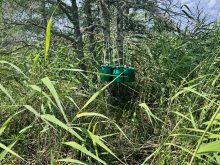Fourteen Alberta feedlots have been approved to receive feeder cattle from the United States.
The Canadian Food Inspection Agency also approved permits for two feedlots in the British Columbia’s Okanagan Valley, and one approval is pending for Saskatchewan.
Ontario has not had any applications for the program.
A permit was issued last year for one feedlot in southern Alberta and another in B.C., where 100 animals arrived.
Most U.S. states are approved to export live animals to Canada under the restricted feeder cattle policy, provided they are brucellosis and tuberculosis free, said CFIA veterinarian Doug Aitken.
Read Also

Research looks to control flea beetles with RNAi
A Vancouver agri-tech company wants to give canola growers another weapon in the never-ending battle against flea beetles.
The program has existed for years but no significant imports have occurred since 2002 because of poor economic returns in the feeding industry.
It was originally called the Northwest Cattle Project and evolved into the restricted feeder program, in which animals could freely enter Canada without disease testing on a year-round basis provided they had proper identification and health certification.
“The current conditions and policies have been around since 2007,” said Aitken, an import specialist for the western region.
One-year permits are granted for terminal and non-terminal feedlots.
Cattle going to a terminal feedlot must go directly to slaughter when they reach market weight, while cattle placed in a non-terminal feedlot may enter the national herd provided they meet health requirements that apply to breeding cattle.
The CFIA does not keep statistics on the number of animals entering feedlots, but market analysts say only a small number have been placed this fall.
Statistics Canada figures indicate the last big surge of imported cattle occurred in 2001 when 141,800 arrived. About 94,900 went to Alberta.
Western Canada was under drought pressure the following year, so only 39,500 were imported.
By 2003, BSE embargoes made imports uneconomical.
Imports are based on market conditions, and it is worth bidding on American cattle this year because barley and other domestic feedstuffs are trading well below the $5 per bushel price for U.S. corn.
Lethbridge barley was trading at $3.42 per bu. Nov. 19 and feed wheat was $4.30 per bu. December futures see both climbing to $178 per tonne.
However, Canada continues to sell large volumes of cattle to the United States, particularly fed cattle.
Canfax reports the country has exported nearly 190,000 feeders in 2010, which is down 28 percent from last year at this time, but fed cattle exports of 552,170 are up 24 percent.

















